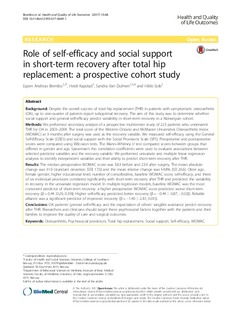| dc.contributor.author | Brembo, Espen Andreas | |
| dc.contributor.author | Kapstad, Heidi | |
| dc.contributor.author | van Dulmen, Sandra | |
| dc.contributor.author | Eide, Hilde | |
| dc.date.accessioned | 2017-06-08T11:11:35Z | |
| dc.date.available | 2017-06-08T11:11:35Z | |
| dc.date.created | 2017-04-11T11:58:57Z | |
| dc.date.issued | 2017 | |
| dc.identifier.citation | Health and Quality of Life Outcomes. 2017, 15 1-10. | nb_NO |
| dc.identifier.issn | 1477-7525 | |
| dc.identifier.uri | http://hdl.handle.net/11250/2445430 | |
| dc.description.abstract | Background Despite the overall success of total hip replacement (THR) in patients with symptomatic osteoarthritis (OA), up to one-quarter of patients report suboptimal recovery. The aim of this study was to determine whether social support and general self-efficacy predict variability in short-term recovery in a Norwegian cohort. Methods We performed secondary analysis of a prospective multicenter study of 223 patients who underwent THR for OA in 2003–2004. The total score of the Western Ontario and McMaster Universities Osteoarthritis Index (WOMAC) at 3 months after surgery was used as the recovery variable. We measured self-efficacy using the General Self-Efficacy Scale (GSES) and social support with the Social Provisions Scale (SPS). Preoperative and postoperative scores were compared using Wilcoxon tests. The Mann–Whitney U test compared scores between groups that differed in gender and age. Spearman’s rho correlation coefficients were used to evaluate associations between selected predictor variables and the recovery variable. We performed univariate and multiple linear regression analyses to identify independent variables and their ability to predict short-term recovery after THR. Results The median preoperative WOMAC score was 58.3 before and 23.9 after surgery. The mean absolute change was 31.9 (standard deviation [SD] 17.0) and the mean relative change was 54.8% (SD 26.6). Older age, female gender, higher educational level, number of comorbidities, baseline WOMAC score, self-efficacy, and three of six individual provisions correlated significantly with short-term recovery after THR and predicted the variability in recovery in the univariate regression model. In multiple regression models, baseline WOMAC was the most consistent predictor of short-term recovery: a higher preoperative WOMAC score predicted worse short-term recovery (β = 0.44 [0.29, 0.59]). Higher self-efficacy predicted better recovery (β = −0.44 [−0.87, −0.02]). Reliable alliance was a significant predictor of improved recovery (β = −1.40 [−2.81, 0.01]). Conclusions OA patients’ general self-efficacy and the expectation of others’ tangible assistance predict recovery after THR. Researchers and clinicians should target these psychosocial factors together with the patients and their families to improve the quality of care and surgical outcomes. | nb_NO |
| dc.language.iso | eng | nb_NO |
| dc.relation.uri | https://hqlo.biomedcentral.com/articles/10.1186/s12955-017-0649-1 | |
| dc.rights | Navngivelse 4.0 Internasjonal | * |
| dc.rights.uri | http://creativecommons.org/licenses/by/4.0/deed.no | * |
| dc.title | Role of self-efficacy and social support in short-term recovery after total hip replacement: a prospective cohort study | nb_NO |
| dc.type | Journal article | nb_NO |
| dc.type | Peer reviewed | nb_NO |
| dc.description.version | publishedVersion | nb_NO |
| dc.source.pagenumber | 1-10 | nb_NO |
| dc.source.volume | 15 | nb_NO |
| dc.source.journal | Health and Quality of Life Outcomes | nb_NO |
| dc.identifier.doi | 10.1186/s12955-017-0649-1 | |
| dc.identifier.cristin | 1464807 | |
| cristin.unitcode | 222,90,3,0 | |
| cristin.unitcode | 222,90,0,0 | |
| cristin.unitname | Institutt for sykepleievitenskap - Drammen | |
| cristin.unitname | Fakultet for helsevitenskap | |
| cristin.ispublished | true | |
| cristin.fulltext | original | |
| cristin.qualitycode | 1 | |

